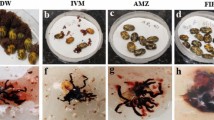Abstract
Medicinal plant extracts from 27 plant species in 20 families were tested for their larvicidal activity against housefly, Musca domestica (L.). Responses varied with plant material and concentration. Among plant species tested, Phryma leptostachya var. asiatica showed 100% larvicidal activity against M. domestica at 10 mg/g concentration. Larvicidal activities of Atractylodes japonica, Saussurea lappa, Asiasarum sieboldi, and Gleditsia japonica var. koraiensis were 89.3%, 85.3%, 93.3%, and 96.6% at 10 mg/g concentration, respectively. Extracts of Prunus persica, Curcuma longa, and Paeonia moutan produced moderate activity. Larvicidal activity of other plant extracts was less than 50%. Among test plant species, P. leptostachya var. asiatica showed the most potent larvicidal activity. The active constituent of P. leptostachya var. asiatica roots was identified as the leptostachyol acetate by spectroscopic analysis. The LC50 values of leptostachyol acetate against M. domestica larvae were 0.039 mg/g. Naturally occurring medicinal plant extracts and P. leptostachya var. asiatica root-derived compounds merit further study as potential housefly larval control agents or lead compounds.
Similar content being viewed by others
References
Ahmed SM, Chander H, Pereira J (1981) Insecticidal potential and biological activity of india indigenous plants against Musca domestica. Int Pest Contr 23:170–175
Alexenizer M, Dorn A (2007) Screening of medicinal and ornamental plants for insecticidal and growth regulating activity. J Pest Sci 80:205–215
Bisseleua HBD, Gbewonyo SWK, Obeng-Ofori D (2008) Toxicity, growth regulatory and repellent activities of medicinal plant extracts on Musca domestica L. (Diptera: Muscidea). Afr J Biotechnol 7:4635–4642
Choi IH, Park JY, Shin SC, Park IK (2006) Nematicidal activity of medicinal plant extracts and two cinnamates isolated from Kaempferia galanga L. (Proh Hom) against the pine wood nematode, Bursaphelenchus xylophilus. Nematology 8:359–365
Elango G, Rahuman AA (2011) Evaluation of medicinal plant extracts against ticks and fluke. Parasitol Res 108:513–519
Förster M, Klimpel S, Mehlhorn H, Sievert K, Messler S, Pfeffer K (2007) Pilot studies on synantropic flise (e.g. Musca, Sarcophaga, Calliphora, Fania, Lucilia, Stomoxys) as vectors of pathogenic microorganisms. Parasitol Res 101:243–246
Ishibashi F, Taniguchi E (1998) Synthesis and absolute configuration of the insecticidal sesquilignan (+)-haedoxan A. Phytochemistry 2:613–622
Kamaraj C, Rahuman AA, Mahapatra A, Bagavan A, Elango G (2010) Insecticidal and larvicidal activities of medicinal plant extracts against mosquitoes. Parasitol Res 107:1337–1349
Kang SH (2010) Study on the integrated pest management utilizing natural enemy (Parasitoids) of filth fly in the livestock farm. Ph.D. dissertation, Kangwon National University
Kim J, Park IK (2008) Fumigant toxicity of Korean medicinal plant essential oils and components from Asiasarum sieboldi root against Sitophilus oryzae L. Flavour Frag J 23:79–83
Kim SI, Roh JY, Kim DH, Lee HS, Ahn YJ (2003) Insecticidal activities of aromatic plant extracts and essential oils against Sitophilus oryzae and Callosobruchus chinensis. J Stored Prod Res 39:293–303
Lee SM, Min BS, Kho YH (2002) Brine shrimp lethality of the compounds from Phryma leptostachya L. Arch Pharm Res 25:652–654
Malik A, Singh N, Satya S (2007) House fly (Musca domestica): a review of control strategies for a challenging pest. J Environ Sci Health B 42:453–469
Park IK, Lee HS, Lee SG, Park JD, Ahn YJ (2000) Insecticidal and fumigant activities of Cinnamomum cassia bark-derived materials against Mechoris ursulus (Coleoptera: Attelabidae). J Agric Food Chem 48:2528–2531
Park IK, Shin SC, Kim CS, Lee HJ, Choi WS, Ahn YJ (2005) Larvicidal activity of lignans identified in Phryma leptostachy var. asiatica roots against three mosquito species. J Agric Food Chem 53:969–972
Park IK, Kim J, Lee YS, Shin SC (2008) In vivo fungicidal activity of medicinal plant extracts against phytopathogenic fungi. Int J Pest Manage 54:63–68
Pharmacognosy Research Association (1991) Modern pharmacognosy. Seoul, Hakchangsa
SAS Institute. SAS/STAT user’s guide (2004) Version 9.2; SAS Institute: Cary, NC
Senthikumar N, Varma P, Gurusubramanian (2009) Larivicidal and adulticidal activities of some medicinal plants against the malarial vector, Anopheles stephensi (Liston). Parasitol Res 104:237–244
Siriwattanarungsee S, Sukontason KL, Olson JK, Chailapakul O, Sukontason K (2008) Efficacy of neem extract against the blowfly and housefly. Parasitol Res 103:535–544
Taniguchi E, Ohima Y (1969) The structure of a novel lignan, phrymarolin-II from Phryma leptostachya L. Agr Biol Chem 33:466–468
Taniguchi E, Oshima Y (1972a) Phrymarolin-I, a novel lignan from Phryma leptostachya L. Agr Biol Chem 36:1018–1025
Taniguchi E, Oshima Y (1972b) Structure of phrymarolin-II. Agr Biol Chem 36:1489–1496
Taniguchi E, Oshima Y (1972c) New gmelinol-type lignin, leptostachyol acetate. Tetrahedron Lett 8:653–656
Taniguchi E, Imamura K, Ishibashi F, Matsui T, Nishio A (1989) Structure of the novel insecticides sesquilignan, haedoxan A. Agr Biol Chem 53:631–643
Yamauchi S, Taniguchi E (1991) Synthesis and insecticidal activity of lignan analogs (I). Agr Biol Chem 55:3075–3084
Yamauchi S, Taniguchi E (1992) Synthesis and insecticidal activity of lignan analogs (II). Agr Biol Chem 56:412–417
Author information
Authors and Affiliations
Corresponding author
Rights and permissions
About this article
Cite this article
Seo, SM., Park, IK. Larvicidal activity of medicinal plant extracts and lignan identified in Phryma leptostachya var. asiatica roots against housefly (Musca domestica L.). Parasitol Res 110, 1849–1853 (2012). https://doi.org/10.1007/s00436-011-2709-5
Received:
Accepted:
Published:
Issue Date:
DOI: https://doi.org/10.1007/s00436-011-2709-5




